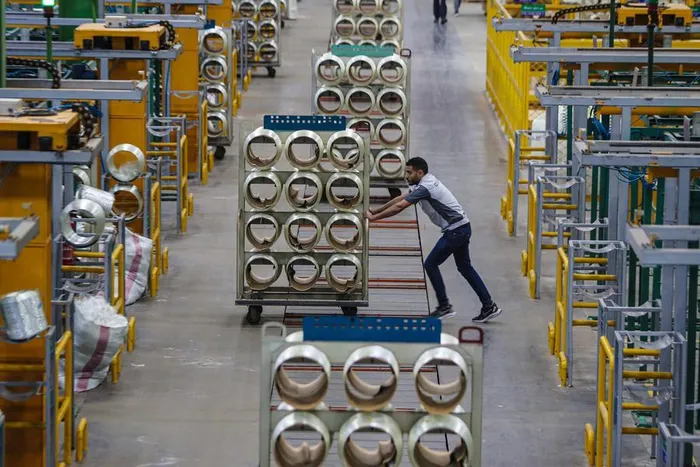Egypt’s Push to Build a New Manufacturing Base

A worker works on the fiberglass production line at a factory of China's fiberglass giant Jushi at China-Egypt TEDA Suez Economic and Trade Cooperation Zone in Suez Province, Egypt.
Image: Xinhua
Egypt is moving quickly to reposition itself as one of Africa’s major automotive manufacturing hubs. The announcement of a new private-sector vehicle plant on the outskirts of Cairo marks more than another industrial project, it signals a shift in how the country wants to build its economy, attract investment and compete in a rapidly changing global manufacturing landscape.
The new plant, backed by Mansour Automotive Group, will anchor what officials describe as a full automotive production zone on 6th of October City. The first phase targets 50,000 vehicles a year, with plans to double output to 100,000 units within five years. What makes this project stand out is not only its scale, but its timing: global automakers are restructuring supply chains, governments are raising localisation targets, and Africa’s demand for vehicles is rising faster than its production capacity.
Egypt now wants to position itself as one of the few African countries capable of manufacturing vehicles at scale and supplying both domestic and export markets.
A Sector Turning Point: Why Egypt Is Betting on Automotive Manufacturing
Africa’s automotive demand has been climbing steadily. According to the African Association of Automotive Manufacturers (AAAM), the continent imports over 85% of its vehicles, mainly used cars, due to limited local production. Only South Africa, Morocco and to some extent Algeria operate sizeable assembly industries. This gap has become an opportunity for governments looking to industrialise, create jobs and reduce import bills.
Egypt is no exception. The country’s car market is one of the largest in North Africa, with an estimated 220,000–250,000 units sold annually before the recent economic slowdown. But domestic production has lagged, leaving the country dependent on imports and exposed to currency shocks.
The government’s new automotive vision aims to change this. The strategy focuses on:
- creating a more stable investment climate for vehicle and component manufacturers,
- pushing local-content requirements above 35%,
- and encouraging the development of an electric-vehicle ecosystem in line with energy-transition goals.
This approach mirrors global trends. Morocco has become a case study in how coordinated investment policies can build an export-oriented manufacturing base. The country now produces 700,000 vehicles a year, exporting to Europe, West Africa and the Middle East. South Africa, which has long established itself as the continent’s production leader, manufactures roughly 500,000 vehicles annually, supported by the Automotive Production and Development Programme (APDP).
Egypt’s new plant is smaller in comparison, but it signals a similar strategic intention: attract global brands, build domestic capacity, and capture a share of the growing African market.
Export Growth, Investment Pressure and the IMF Factor
Egypt’s economic motivation is clear. The country is under pressure to expand non-oil exports, stabilise foreign-currency flows and close a stubborn trade deficit. In 2025, Egypt’s non-oil exports grew by 19% in the first seven months, reaching nearly US$29 billion — a jump from US$24.4 billion a year earlier. Manufacturing has driven a large portion of this growth, especially in chemicals, building materials and food processing.
The automotive industry is now being positioned as the next export driver. New investment incentives, including the Export Subsidy Fund and customs benefits for electric-vehicle manufacturers, are designed to draw foreign capital into production zones.
At the same time, global manufacturers are searching for “China-plus-one” locations — secondary production bases in regions that offer competitive labour costs, favourable trade access and political cooperation with major markets. Egypt’s geographical location gives it access to the EU through trade agreements, to Arab markets through the Greater Arab Free Trade Agreement, and to Africa through the AfCFTA. For automotive companies, this means one plant can reach more than 1.5 billion consumers across three major trade blocs.
The Electric Vehicle Push and Green Industrialisation
One of the most important shifts in Egypt’s strategy is the explicit focus on electric vehicles (EVs). By 2032, the government wants each major automaker in the country to produce at least 7,000 electric units annually. This target may seem small compared to global production figures, but for Africa it is significant. The International Energy Agency (IEA) estimates that EV penetration in Africa remains below 1%, mainly due to weak charging infrastructure and high vehicle costs.
Egypt aims to get ahead of the curve by encouraging:
- EV assembly,
- battery-component localisation,
- and investment in charging networks.
If successful, Egypt could position itself as a first mover in Africa’s green-mobility sector, similar to how Morocco now leads in EV wiring systems and South Africa in hybrid-vehicle assembly.
Long-Term Outlook: Can Egypt Become a Regional Manufacturing Powerhouse?
Egypt’s automotive ambitions are bold, but not unrealistic. The fundamentals — a large domestic market, improving export incentives, proximity to multiple regions, and growing private-sector participation — place the country in a competitive position.
However, the long-term success of the sector depends on several conditions:
- stable currency and investment policies,
- deeper integration of local component manufacturers,
- competitive logistics costs,
- and consistent demand across Africa.
If these factors align, Egypt could become a major player in African car manufacturing within the next decade. The new plant near Cairo is not just another factory. It is the opening move in a broader industrial strategy — one that seeks to shift Egypt from an import-heavy economy to a manufacturing and export-driven one.
In a continent hungry for industrialisation and mobility access, Egypt’s automotive push could reshape regional production patterns and strengthen Africa’s manufacturing future.
Written By:
Chloe Maluleke
Associate at BRICS+ Consulting Group
Russia & Middle East Specialist
** MORE ARTICLES ON OUR WEBSITE https://bricscg.com/
** Follow https://x.com/brics_daily on X/Twitter for daily BRICS+ updates
Related Topics: